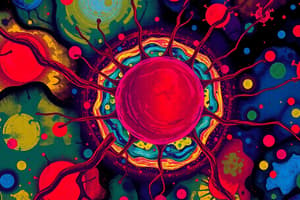Podcast
Questions and Answers
Which process specifically involves the movement of water molecules across a semipermeable membrane?
Which process specifically involves the movement of water molecules across a semipermeable membrane?
A benign tumor is characterized by uncontrolled cell division and the ability to spread to other parts of the body.
A benign tumor is characterized by uncontrolled cell division and the ability to spread to other parts of the body.
False (B)
What is the term for a substance or agent that can cause cancer?
What is the term for a substance or agent that can cause cancer?
Carcinogen
A cell that enters a resting state because it doesn't pass the G1 checkpoint is said to be in the _____ state.
A cell that enters a resting state because it doesn't pass the G1 checkpoint is said to be in the _____ state.
Signup and view all the answers
Match the following terms with their descriptions:
Match the following terms with their descriptions:
Signup and view all the answers
Which of the following best describes the process of metastasis?
Which of the following best describes the process of metastasis?
Signup and view all the answers
All mutations in a cell's DNA directly lead to the development of cancer.
All mutations in a cell's DNA directly lead to the development of cancer.
Signup and view all the answers
Cancer cells lose their ______ ______, which is when normal cells stop dividing when they get too close to each other.
Cancer cells lose their ______ ______, which is when normal cells stop dividing when they get too close to each other.
Signup and view all the answers
What is assessed at the G1 checkpoint?
What is assessed at the G1 checkpoint?
Signup and view all the answers
If a cell has irreparable DNA damage at the G2 checkpoint, it will proceed to mitosis.
If a cell has irreparable DNA damage at the G2 checkpoint, it will proceed to mitosis.
Signup and view all the answers
During which phase of mitosis does the spindle checkpoint occur?
During which phase of mitosis does the spindle checkpoint occur?
Signup and view all the answers
Cancer cells lose ___________, which is a characteristic of normal cells.
Cancer cells lose ___________, which is a characteristic of normal cells.
Signup and view all the answers
Match the following cancer treatments with their mechanism:
Match the following cancer treatments with their mechanism:
Signup and view all the answers
Which of the following is NOT a characteristic of cancer cells?
Which of the following is NOT a characteristic of cancer cells?
Signup and view all the answers
Cancer cells typically have a small cytoplasm and multiple nuclei.
Cancer cells typically have a small cytoplasm and multiple nuclei.
Signup and view all the answers
What is a potential side effect of chemotherapy that is related to hair follicle cells?
What is a potential side effect of chemotherapy that is related to hair follicle cells?
Signup and view all the answers
Which of these is NOT a characteristic of living things as described by MRS GREN?
Which of these is NOT a characteristic of living things as described by MRS GREN?
Signup and view all the answers
According to the cell theory, all cells come from non-living material.
According to the cell theory, all cells come from non-living material.
Signup and view all the answers
What is the primary function of the mitochondria?
What is the primary function of the mitochondria?
Signup and view all the answers
The cell membrane is described as being ______, which means it controls which substances can pass in and out of the cell.
The cell membrane is described as being ______, which means it controls which substances can pass in and out of the cell.
Signup and view all the answers
Match the following organelles with their primary function:
Match the following organelles with their primary function:
Signup and view all the answers
What is the correct order of the level of organization of living things from simplest to most complex?
What is the correct order of the level of organization of living things from simplest to most complex?
Signup and view all the answers
Plant cells have centrioles to assist with cell division.
Plant cells have centrioles to assist with cell division.
Signup and view all the answers
What is the name of the process where cancer cells spread to other parts of the body?
What is the name of the process where cancer cells spread to other parts of the body?
Signup and view all the answers
The ______ contains chlorophyll and is the site of photosynthesis.
The ______ contains chlorophyll and is the site of photosynthesis.
Signup and view all the answers
Which of these is NOT a function of vacuoles?
Which of these is NOT a function of vacuoles?
Signup and view all the answers
Which of the following structures are found in plant cells but not in animal cells?
Which of the following structures are found in plant cells but not in animal cells?
Signup and view all the answers
Prokaryotic cells are generally larger and more complex than eukaryotic cells.
Prokaryotic cells are generally larger and more complex than eukaryotic cells.
Signup and view all the answers
What is the main reason cells divide when they reach a certain size?
What is the main reason cells divide when they reach a certain size?
Signup and view all the answers
During the synthesis phase of interphase, ______ replication occurs.
During the synthesis phase of interphase, ______ replication occurs.
Signup and view all the answers
Match the following phases of mitosis with their descriptions:
Match the following phases of mitosis with their descriptions:
Signup and view all the answers
Which of the following is NOT a reason cells divide?
Which of the following is NOT a reason cells divide?
Signup and view all the answers
Cytokinesis is the stage where the nucleus of the cell divides.
Cytokinesis is the stage where the nucleus of the cell divides.
Signup and view all the answers
What is the structure that attaches sister chromatids together?
What is the structure that attaches sister chromatids together?
Signup and view all the answers
In animal cells, the cytoplasm splits during cytokinesis through a process called ______.
In animal cells, the cytoplasm splits during cytokinesis through a process called ______.
Signup and view all the answers
What is the purpose of the G1 checkpoint in the cell cycle?
What is the purpose of the G1 checkpoint in the cell cycle?
Signup and view all the answers
Flashcards
Diffusion
Diffusion
The movement of molecules from an area of high concentration to an area of lower concentration. This can occur through a semipermeable membrane but is not always required.
Osmosis
Osmosis
The movement of water molecules from an area of high water concentration to an area of low water concentration. This movement always occurs through a semipermeable membrane until equilibrium is reached.
Apoptosis
Apoptosis
Programmed cell death where a cell self-destructs during the G2 checkpoint of cell division. This occurs when DNA damage is irreparable.
G0 - resting state
G0 - resting state
Signup and view all the flashcards
Mutation
Mutation
Signup and view all the flashcards
Carcinogen
Carcinogen
Signup and view all the flashcards
Benign
Benign
Signup and view all the flashcards
Malignant
Malignant
Signup and view all the flashcards
Movement
Movement
Signup and view all the flashcards
Respiration
Respiration
Signup and view all the flashcards
Sensitivity
Sensitivity
Signup and view all the flashcards
Growth
Growth
Signup and view all the flashcards
Reproduction
Reproduction
Signup and view all the flashcards
Excretion
Excretion
Signup and view all the flashcards
Nutrition
Nutrition
Signup and view all the flashcards
Death
Death
Signup and view all the flashcards
Cell
Cell
Signup and view all the flashcards
Organelle
Organelle
Signup and view all the flashcards
Prokaryotes
Prokaryotes
Signup and view all the flashcards
Eukaryotes
Eukaryotes
Signup and view all the flashcards
Cell Cycle
Cell Cycle
Signup and view all the flashcards
Interphase
Interphase
Signup and view all the flashcards
Mitosis
Mitosis
Signup and view all the flashcards
G1 Checkpoint
G1 Checkpoint
Signup and view all the flashcards
Prophase
Prophase
Signup and view all the flashcards
Metaphase
Metaphase
Signup and view all the flashcards
Anaphase
Anaphase
Signup and view all the flashcards
Telophase
Telophase
Signup and view all the flashcards
Spindle Checkpoint (M Checkpoint)
Spindle Checkpoint (M Checkpoint)
Signup and view all the flashcards
Loss of Contact Inhibition
Loss of Contact Inhibition
Signup and view all the flashcards
Metastasis
Metastasis
Signup and view all the flashcards
Lack of Specialization in Cancer Cells
Lack of Specialization in Cancer Cells
Signup and view all the flashcards
Abnormal Structure of Cancer Cells
Abnormal Structure of Cancer Cells
Signup and view all the flashcards
Chemotherapy
Chemotherapy
Signup and view all the flashcards
Radiation Therapy
Radiation Therapy
Signup and view all the flashcards
Study Notes
Diffusion
- Movement of molecules from high concentration to low concentration
- Can occur across semi-permeable membranes or not
Osmosis
- Movement of water molecules from high water concentration to low water concentration
- Occurs across a semi-permeable membrane
- Continues until equilibrium is reached
Apoptosis
- "Cellular suicide"
- A cell kills itself during the G2 checkpoint
- Irreversible DNA damage
- Programmed cell death
Go-resting state
- If a cell does not pass the G1 checkpoint, it may enter a resting state
- Delays replication until conditions improve
Mutation
- A permanent change in a cell's DNA
- All cancers begin with a mutation
- Mutations affect how the cell responds to division signals
- Can be passed to other cells through mitosis (but not all cause cancer)
Carcinogen
- Substances, organisms, or agents that can cause cancer
- Examples: chemicals, radiation, infectious agents
Benign Tumor
- Harmless tumor
- Cell division is controlled
- Slow-growing
- Not invasive, does not spread
Malignant Tumor
- Cancerous tumor
- Uncontrolled cell division
- Rapid growth
- Invasive, spreads to other parts of the body
Contact Inhibition
- Normal Cells: Cells stop dividing when they come into contact with other cells
- Cancer Cells: Cells lose contact inhibition, continue to divide even when crowded
Metastasis
- Cancer cells detach from original tumor
- Move and divide in other parts of the body
- Makes treatment harder
MRS GREND
- Movement - ability to move
- Respiration - cellular respiration to produce energy
- Sensitivity - ability to detect and respond to changes in the environment
- Growth - increase in size
- Reproduction - producing offspring
- Excretion - removing waste
- Nutrition - obtaining food for energy and growth
- Death - all organisms have a limited lifespan
Cell Theory
- Organisms are composed of one or more cells
- Cells are the basic unit of structure and organization in living things
- Cells come only from pre-existing cells
Organelles
- Nucleus - controls cell activity, houses DNA;
- Centrioles - involved in cell division.
Cytoplasm
- Jelly like substance
- surrounds and cushions organelles
- Maintains internal pressure for chemical reactions
Cell Membrane
- thin and flexible surrounds the cell
- controls flow of materials in and out of the cell (semi-permeable)
Mitochondria
- oval with folds
- produces energy for cell through cellular respiration
Golgi Apparatus
- pancake stack with Protein
- processes and packages protein for shipment
Endoplasmic Reticulum
- Rough or Smooth
- Rough has ribosomes attached which synthesis proteins
- Smooth Synthesizes or transports fats
Ribosomes
- Small round dots with no membrane
- Create proteins
- break down waste and bacteria
Vacuoles
- Liquid-filled space with a thin membrane
- stores water, food and waste
Cell Wall
- Thick layer of cellulose (plants only)
- protects and supports the cell
Chloroplast
- Small green discs containing chlorophyll (plants only)
- Site of photosynthesis
Animal Cell vs Plant Cell
- Animal cells have centrioles and plant cells do not.
- Plant cells have a cell wall and vacuole.
- Both cells have a nucleus, membrane, cytoplasm, and other organelles.
Prokaryotic vs Eukaryotic Cells
- Prokaryotic: always unicellular, no membrane-bound organelles, simple structure, bacteria, archaea.
- Eukaryotic: unicellular or multicellular, many membrane-bound organelles, complex structure, animals, plants, fungi, protists.
Reasons for Cell Division
- Reproduction: passing DNA from one generation to the next
- Growth: the increase/division of cells is needed for organisms grow
- Repair: damaged cells need to be replaced.
Cell Cycle
- G1: growth and preparation for DNA replication
- S: DNA replication
- G2: preparation for mitosis
- M: mitosis (prophase, metaphase, anaphase, telophase)
Prophase
- Chromatin condenses into chromosomes.
- Centrioles move to opposite ends of the cell.
- Nuclear membrane starts to break down.
- Spindle fibers appear.
Metaphase
- Chromosomes line up in the middle of the cell, attached to spindle fibers.
Anaphase
- Sister chromatids separate and move to opposite ends of the cell.
Telophase
- Chromosomes reach opposite ends of the cell.
- Nuclear membranes reform.
- Chromosomes de-condense.
- Spindle fibers disappear.
Cytokinesis
- Cytoplasm divides, creating two new daughter cells.
Stages for Cell Division Checkpoints
- Cell size, nutrient availability, molecular signals, and DNA integrity (G1)
- DNA replication completeness (G2)
- Attachment of each chromosome to the spindle fibers (M)
Characteristics in Cancer Cells
- loses contact inhibition
- lack specialization
- abnormal structures(many nuclei)
- lack cytokinesis/interphase
Studying That Suits You
Use AI to generate personalized quizzes and flashcards to suit your learning preferences.
Related Documents
Description
Test your knowledge on key concepts of cell biology including diffusion, osmosis, apoptosis, and the role of mutations in cancer development. This quiz will challenge your understanding of cellular processes and their implications. Perfect for students studying biology at any level.




